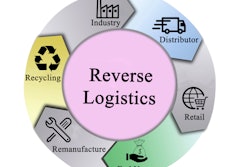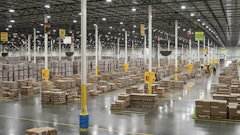
As e-commerce continues to grow, increased order volumes means a corresponding increase in returns. According to the National Retail Federation and Happy Returns, U.S. retail returns totaled $890 billion in 2024. While a majority of consumers (76%) find free returns to be one of the deciding factors when making a purchasing decision, the “perk” is causing serious strain on businesses. More than two-thirds of retailers surveyed said they were prioritizing upgrading their returns capabilities within the first six months of 2025.
What is reverse logistics?
Returns are a year-round challenge for warehouse managers, but the post-holiday period traditionally tests the limits of warehouse capacities, as well as efficiencies of return processes. It is no wonder companies have decided to invest more in reverse logistics with the influx of returns. However, as returned items pour into warehouses at overwhelming rates, conventional manual methods are falling short, unable to handle the surge, creating bottlenecks and dissatisfied customers.
For businesses, returns are a costly and complex operation, involving a number of steps once the products are received back at the warehouse: from assessing the condition of the return, to sorting it and putting it away on the warehouse floor, the task involves strong coordination within a business. This process of moving goods from the end consumer back to the warehouse of the manufacturer or a third-party logistics provider (3PL) is called reverse logistics. It is a critical element of the customer experience. From product returns to refurbishment and repairs, recycling of packaged materials, and disposing of end-of-life products, reverse logistics involves many areas of an organization, including sales, finance, and even environmental compliance.
Streamlining operations through automation
Technologies like warehouse automation and robotics can transform returns management into a streamlined operation. By leveraging innovative solutions, warehouses can smoothly tackle even the highest volume of post-holiday returns, guided by AI-powered predictions. Warehouse automation provides much-needed optimization to get returns back on shelves faster.
Autonomous mobile robots (AMRs) transport returned goods from receipt to designated storage locations far faster than human associates navigating crowded warehouses alone. Humans and robots work together, with the robots taking on the tedious and process of navigating a warehouse, while humans are the ones placing items on the robots; putting the returned goods away; and applying strategic thinking and problem solving.
Innovative warehouse automation platforms now incorporate AI and machine learning to enhance managers’ decisions and workflows. These solutions can be utilized to determine whether returned items should get resold, refurbished, or recycled. AI can also help create some “predictability” in volume management and labor allocation. With one program, a warehouse can validate returns and oversee restocking with software that gets smarter over time. Another area where automation supports returns process is through integrating technologies like tilt tray sorters which amplify sorting capacity. These automated systems evaluate returned merchandise and divert inventory to appropriate stations for processing, minimizing time-draining manual sorting while reducing costly errors.
Lightening the load
However, easing the logistical nightmare of returns is not the only benefit of warehouse automation. AI-powered solutions can create efficient and productive workflows for human employees who are handling returns, and autonomous robots can help ease the labor-intensive aspects of their day-to-day responsibilities. Through handling heavy items and walking up to a dozen miles a day, employees are put at risk of physical strain which can lead to injury and time away from work. Through automation, employees can focus on strategic decisions while AI and robotics take labor-intensive processes.
With robotics tackling intense manual labor, humans can focus on both picking and returns (or “putaway”) in warehouses to increase efficiency. This “interleaving” workflow, both tasks are being performed by the same pool of human workers as directed by the robot. For example, a worker may be in an aisle with two robots, one requiring a pick task and one a return. By completing both nearby tasks, companies can I increase task density, minimize the distance between robots, and decreases walk time, which increases the efficiency rates for both picking and returns in your warehouses. With this approach, labor-challenged companies can also avoid the need for a separate overnight shift that focuses only on restocking and putaway and instead optimize their existing workforce.
Achieving success through automation
Warehouse automation offers hope by increasing processing velocity, improving accuracy, and reducing unnecessary handling. The latest robotics and AI tools elevate returns from a warehouse's greatest vulnerability to one of its strongest profit drivers. When an influx in returns threatens to sink warehouses, innovation keeps them afloat. By investing in automation and analytics, managers can streamline operations to see true success. The warehouses that will thrive are those embracing technology to turn returns into revenue while making customers happy.


![Pros To Know 2026 [color]](https://img.sdcexec.com/mindful/acbm/workspaces/default/uploads/2025/08/prostoknow-2026-color.mduFvhpgMk.png?auto=format%2Ccompress&bg=fff&fill-color=fff&fit=fill&h=100&q=70&w=100)







![Pros To Know 2026 [color]](https://img.sdcexec.com/mindful/acbm/workspaces/default/uploads/2025/08/prostoknow-2026-color.mduFvhpgMk.png?ar=16%3A9&auto=format%2Ccompress&bg=fff&fill-color=fff&fit=fill&h=135&q=70&w=240)









